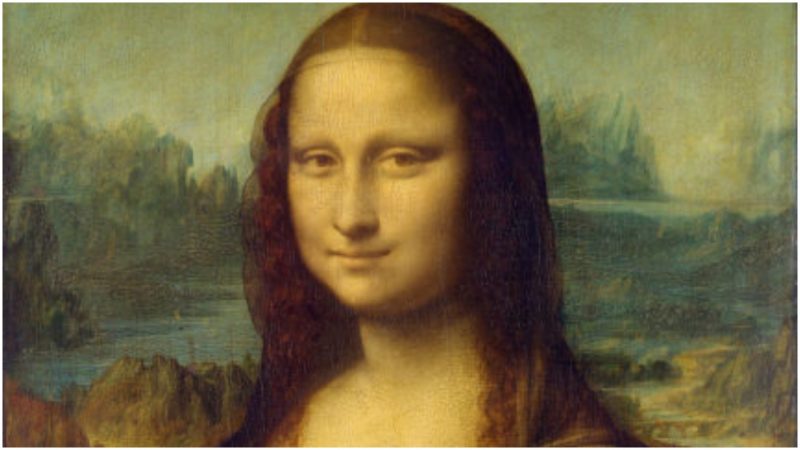In times past, when people were forbidden to express their opinion or beliefs publicly, or it was considered rude to let your true feelings be known, a painting or a sculpture was a suitable medium in which an artist could hide a message.
Many of these messages were often political, moral, or based on religious allegories. However, some of them had a purely amusing character – the artist’s way of having some fun and leaving his personal mark on the canvas. All throughout history, especially in the middle ages and the Renaissance, famous artists have placed hidden meanings within their works of art. Here is a selection of some of the most intriguing hidden messages in a collection of paintings from the rich history of art.
Leonardo da Vinci, The Last Supper

Leonardo da Vinci’s Last Supper is one of his most discussed works of art amongst conspiracy theorists who regularly find hidden codes in his work. It turns out that the “Last Supper” is full of secret codes and meanings. We’re not talking here about the cryptograms that, according to Dan Brown, the author of The Da Vinci Code, hold the secrets of Jesus’s later life, or about the allegations that a hidden mathematical and astrological code within the painting reveals the day when the end of the world will begin (which, by the way, is March 21, 4006).
Along with all of the codes, Leonardo seems to have left us some music too – something like a graphic representation of the sounds of his age. At first glance, the way the bread rolls are scattered across the table don’t appear to reveal anything mysterious, and you’d have to spend a lot of time and imaginative energy on them to come up with anything approaching a hidden message.
However, several years ago, an Italian computer technician called Giovanni Maria Pala did exactly this and found something fascinating – a music sheet left by Da Vinci himself. If the five lines of a musical staff are drawn on the table of the Last Supper, then each bread roll in combination with the hands of the Apostles corresponds with a certain musical note.
When the notes are read from right to left (the way Da Vinci wrote), the combination of notes transforms into a 40-second long composition that sounds like a requiem. Of course, there is always a chance that this is pure coincidence, but the fact is the compositions sound very harmonious when played. Researchers also know that besides being a painter, Da Vinci was also an excellent musician and inventor.
Michelangelo, Separation of Light from Darkness, the Sistine, Chapel Ceiling
This next secret message appears in the work of another Renaissance artist, a famous contemporary of Da Vinci called Michelangelo. Among his most notable pieces of art is his massive painting on the ceiling of the Sistine Chapel. This huge masterpiece is divided into nine segments, and each of them tells a different story from the Book of Genesis.
Michelangelo was obviously a genius and a true renaissance man: a painter, a sculptor, an architect, and, among other things, an expert in human anatomy. We know this because of his sculptures and because he managed to hide a few anatomical elements in his paintings. As a young man, Michelangelo used to dissect corpses from the graveyard, and during this rather gruesome period in his life, he learned a lot about the human body.
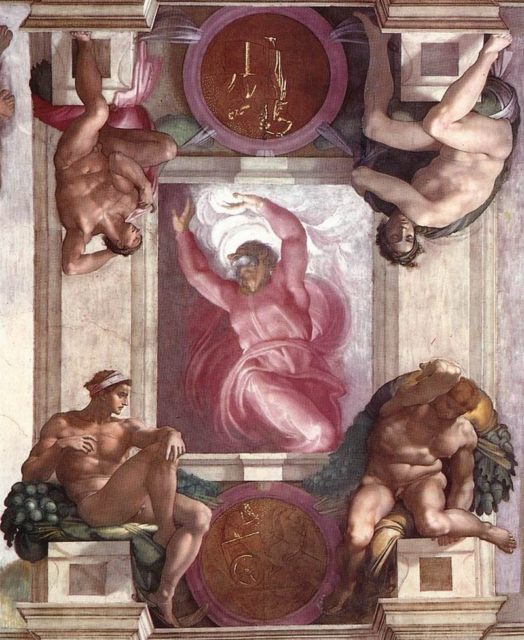
Besides the notes he made, he hid parts of his knowledge in some of the segments on the ceiling of the Sistine Chapel. For example, if we take a careful look at the segment called “Separation of Light from Darkness” we see that the neck and chin of God resembles the image of a human brain.
So why did Michelangelo hide anatomical sketches inside his art? More and more theorists believe that this was Michelangelo’s protest against the church’s refusal to accept scientific fact.
Michelangelo, The Creation of Adam, the Sistine, Chapel Ceiling
It seems like Michelangelo was fascinated by the human brain. In another popular segment of his masterpiece on the ceiling of the Sistine Chapel, he inserted another image of the brain. We’ve all seen the painting known as “The Creation of Adam” at one point or another. After all, it’s one of the most replicated religious paintings of all time.
God, carried by twelve figures, stretches his hand and nearly touches the hand of Adam, transmitting to him the spark of life. At first, we think that the whole composition is merely an allegory of the relationship between man and God, but some experts analyzed the painting and noticed that God and the twelve figures are pictured against a swirling cloak which closely resembles the structure of the human brain.
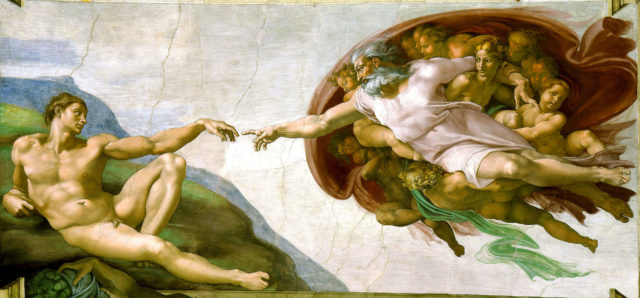
This cannot be a simple coincidence because Michelangelo even managed to depict some of the more complex brain parts, such as the cerebellum, optic chiasm, and pituitary gland. For example, the figure beneath God, wearing a green scarf, is an almost perfect representation of the vertebral artery.
Vincent Van Gogh, Cafe Terrace At Night
When we look at “Cafe Terrace at Night,” considered as one of Van Gogh’s most valuable paintings, his mesmerizing brush movements, and choice of beautiful, vibrant colors are the first things that catches the eye.
The scene is fairly simple – it’s night, and a bunch of people are having a drink at the half-empty cafe. But it turns out that there is more to the painting than this pleasant street scene. Many art researchers believe that Van Gogh actually created his own portrayal of the Last Supper with this painting.
Those who support this theory explain that the possibility of this painting being a depiction of the Last Supper is strong. After all, Van Gogh was the son of a Protestant minister and was very religious himself. So where is the evidence for this theory? We all know that Jesus had his Last Supper together with his twelve disciples.
Exactly twelve people are sitting at the cafe in Van Gogh’s painting, all of them centered around a long-haired figure that is either their waiter or Jesus himself. To make the theory more believable, there are several hidden crosses scattered around the composition, one of which is above the Christ-like figure.
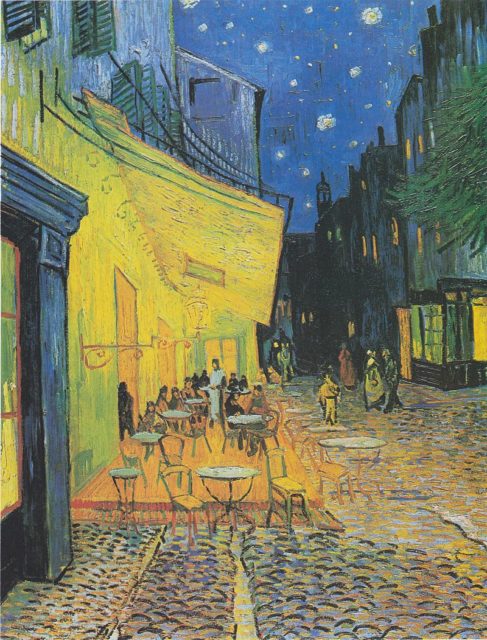
Van Gogh never spoke about this painting having any religious symbolism, although, in one letter to his brother Theo, he writes the following: “That doesn’t stop me having a terrible need for – dare I say the word – for religion. So I go outside at night to paint the stars, and I always dream a painting like that with a group of living figures of the pals.”
Leonardo da Vinci, Mona Lisa
Steeped in mystery, this enigmatic masterpiece has been baffling researchers and art historians for centuries. Now Italian scholars have added another layer of intrigue by announcing that Da Vinci left a series of very small letters and numbers. Viewed under a microscope, it’s possible to make out the letters LV in Mona Lisa’s right eye.
There are some more symbols in her left eye, but not as visible as the others. They resemble the letters CE, or the letter B.
The arch of the bridge in the background of the painting has an inscription that is either the number 72 or the letter L and the number 2. Behind the painting, there is the number 149 and a fourth number in the sequence that is erased.
Researchers speculate that this was probably the year when the painting was made (when Da Vinci was in Milan during the 1490s). What these numbers and letters really stand for is something that only Da Vinci knew.
6 Sandro Botticelli, Primavera
This Botticelli masterpiece has a lot to offer the curious eyes of those who indulge in the searching of hidden symbols and meaning in artworks.
The origin of the painting is a little bit unclear. It was either commissioned by Lorenzo de’ Medici, or it may have been commissioned somewhat later by his cousin, Lorenzo di Pierfrancesco de’ Medici. Either way and perhaps more importantly, it was created in the court of one of the most progressive families of the time.
The painting, which is full of characters from Roman mythology, is according to scholars (Cunningham and Reich) an “elaborate mythological allegory of the burgeoning fertility of the world.” Besides this obvious mythical explanation and representation of Springtime, there are many interpretations of the scene depicted in the painting. Some people think that it provides clues to a plot against the Medici family and some who think that it is connected with the Pagan Renaissance Revival and Neoplatonic philosophy.
Marsilio Ficino, who spoke about this idea, was Florence’s foremost philosopher. He believed that man possessed a spark of divinity, which contrasted with the medieval view of man’s guilt and culpability.
This is probably why the painting looks like a 1960s hippie gathering. Besides all the controversy, there is something else that makes it very special – the painting is a botanical heaven. In the imaginary meadow depicted in Primavera (Spring), Botticelli painted an astonishing number of plants with an amazing degree of detail.
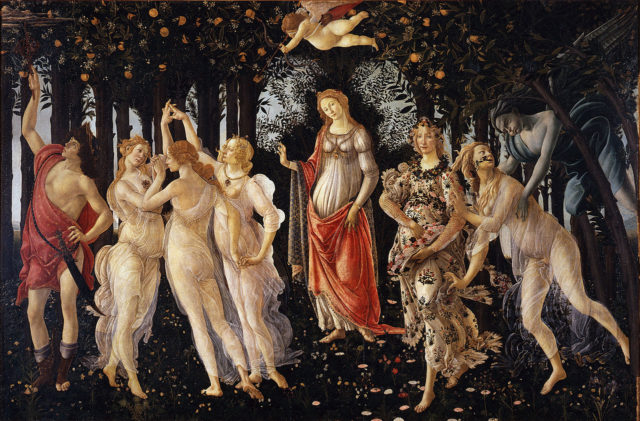
According to botanists that did research on the painting, there are at least 500 individual plants that can be classified as over 200 different species. One theory suggests that they are all the plants that grew around Florence during springtime in the 15th century.
7 Giorgione, The Tempest
In Giorgione’s “The Tempest,” we see two figures, one male, and the other female. They are both outside the walls of an unknown city, and it looks like a storm is coming.
The painting looks very simple and straightforward, but throughout the years, many scholars have analyzed it and tried to find the best interpretation. The young man standing on the right has been described as a soldier, shepherd, gypsy, or young aristocrat. The woman, sitting opposite him, is either a gypsy, a prostitute, Eve, or Mary, mother of Jesus, on the Flight into Egypt. There is also a stork on one of the rooftops, which according to some is a symbol of the love of the parents for their children.
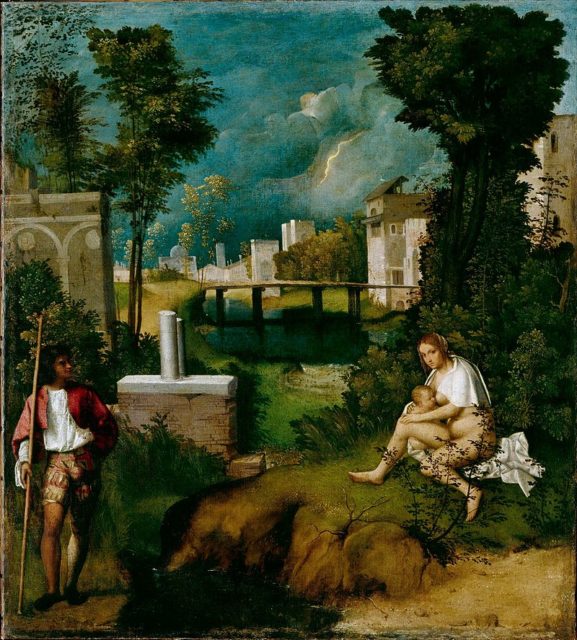
Everything around seems to be silent, in expectation of the upcoming storm. According to an Italian scholar called Salvatore Settis, the city in the background is a representation of Paradise, while the two characters are Adam and Eve with their son Cain. In ancient Greek and Hebrew mythology, the lightning in the sky is a representation of God.
Settis thinks that the painting shows the moment when God chased Adam and Eve from Eden. This is just one of the explanations of “The Tempest,” a painting that many scholars consider as one of the most enigmatic works of art. Some go so far as to believe that it is haunted by the spirit of its author who resides inside of it.
8 Pieter Bruegel the Elder, Netherlandish Proverbs
There is nothing mysterious within this painting made by Pieter Bruegel, the Elder, but still, it is no less interesting than the others mentioned above. “Netherlandish Proverbs” can be described as a massive literal interpretation of proverbs found in the Dutch language. Bruegel managed to paint a huge number of proverbs that were popular in his time.
In the whole scene, researchers managed to identify around 112 Proverbs, but there are very likely more than that which are either unexplainable from our perspective or really well hidden.
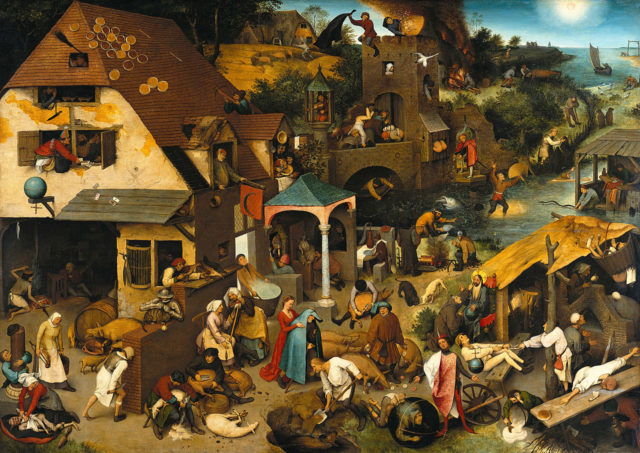
If you take a moment and look at the painting, you will notice that there are a few proverbs that are still in use today, proverbs such as: “swimming against the tide,” “the big fish eats the little fish,” “banging one’s head against a brick wall,” and “armed to the teeth.”
9 Hieronymus Bosch, The Garden of Earthly Delights
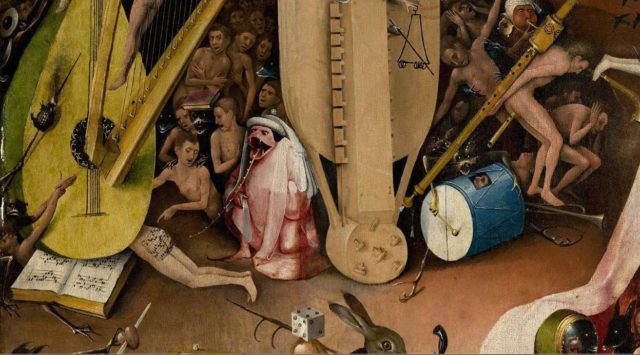
The work of Hieronymus Bosch is famous for its fantastic imagery, detailed landscapes, and illustrations of religious concepts and narratives. Bosch was a master in depicting the grotesque. Every single Bosch painting looks like a massive hidden object game made to test your ability to notice small details.
Among all the amusing objects and situations that one can see in one of Bosch’s paintings, three years ago, a blogger called Amelia posted on her Tumblr account saying that she had found some hidden musical notes in one of his paintings. While she and her friend were looking at Hieronymus Bosch’s triptych called The Garden of Earthly Delights, they noticed something very amusing in the last segment which is a representation of hell.
There was some sheet music printed or “tattooed” on the butt of one of the characters condemned to be tortured in Hell. Very soon, played versions of the “Sinner’s Hymn” appeared across the internet.
10 Caravaggio, Bacchus
Caravaggio’s Bacchus is one of his most acclaimed paintings. Today it can be seen hanging in Florence’s Uffizi Gallery. The painting, made in 1595, shows the Roman god Bacchus (Dionysus) while he enjoys himself, drinking a glass of wine and inviting the viewer to join him.
The whole setting looks pretty ordinary, with nothing more to tell than the obvious: come and join me for a drink; but eight years ago, a group of experts using a modern technology called reflectography, managed to see something peculiar inside the carafe of wine sitting in the bottom left corner. Caravaggio made a portrait of himself inside the bottle!
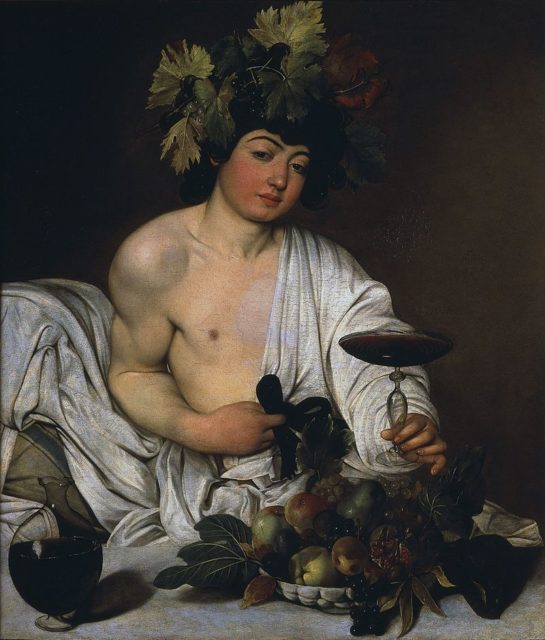
The portrait, which appears in the reflection of light on the surface of the wine, shows him at the age of 25, with dark curly hair, holding a paint brush and working at an easel.
The tiny portrait was first spotted in 1922 when a restorer cleaned the canvas. It was revealed under the centuries of grime that was covering this old painting. Because of the poor restoration process, the image became gradually darker and darker until it disappeared. Thanks to modern technology we are now able to see Caravaggio’s amusing depiction of himself again.
